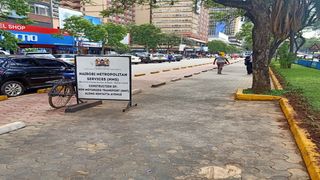
A section of the refurbished Kenyatta Avenue in Nairobi which has no single litter bin for pedestrians to use.
| Francis Nderitu | Nation Media GroupNairobi
Premium
How garbage menace threatens to soil NMS' ‘clean’ image
What you need to know:
- A stroll through multiple streets and avenues around the Nairobi CBD shows that there are very few litter bins around.
- Garbage menace is proving to be a litmus test for the Major-General Mohammed Badi-led administration.
A litter bin stands desolate outside Emperor Plaza at the junction of Koinange Street and Kenyatta Avenue.
A walk along Kenyatta Avenue, Wabera and Muindi Mbingu streets reveals a similar picture. Litter bins that once dotted the three streets are nowhere to be seen.
Construction of non-motorised transport lanes along the three transport corridors has wiped out the bins, making life hard for responsible residents looking for somewhere to dump litter.
But the problem is not entirely restricted to the three areas with the number of bins, which were once placed strategically along different streets and avenues in the city centre, gradually reducing in number.
A stroll through multiple streets and avenues around the Nairobi central business district shows that there are very few litter bins around.
Indeed, the large waste segregation bins that dotted certain lanes and streets also suddenly went missing without any replacement.

A section of the refurbished Muindi Mbingu Street in Nairobi which has no litter bins for pedestrians to use.
Nairobi Metropolitan Services Director of Environment Stephen Nzioka says they removed the litter bins because they were poorly placed right in the middle of the NMT corridor.
He, nonetheless, said the bins will soon be replaced once work on the corridors is complete and the right spots for the bins are identified.
“We removed the litter bins because they were wrongly placed right in the middle of the NMT corridor. They were going to interfere with the free movement of residents who ride their bicycles along the corridor so we decided to address the challenge. We will, however, replace them in right places along the corridor,” said Mr Nzioka.
Garbage menace is proving to be a litmus test for the Major-General Mohammed Badi-led administration.
The nascent office has won the hearts of many city residents with its infrastructure work since taking over key Nairobi county government functions in March this year.
However, solid waste management in the capital is proving to be a thorn in the flesh of the outfit which could end up being its Achilles heel.

A section of the refurbished Kenyatta Avenue in Nairobi which has no single litter bin for pedestrians to use.
Uncollected garbage
Despite the insistence by the administration that it has upped collection of garbage in the city from 1,000 tons a day previously done by City Hall to 3,000 tons daily, the situation on the ground is different.
Most recent data from City Hall estimates that the more than four million Nairobi residents produce 2,500 tons of solid waste each day. Therefore, if the collection is at 3,000 tons every day as is claimed by NMS, then the city would be sparkling clean.
Many areas across the city, especially in informal settlements, still grapple with mounds of uncollected garbage.
In its defence, NMS over a week ago accused “saboteurs and detractors” of undoing their good work by piling heaps of garbage where the same has been collected.
The office pointed accusing fingers at City Hall for failure to pay garbage contractors and frustrating NMS’ efforts to engage the contractors by holding onto their contracts.
This has led to the contractors going on strike, forcing NMS to rely only on National Youth Service personnel and trucks to collect the garbage.

A section of the refurbished Kenyatta Avenue in Nairobi which has no single litter bin for pedestrians to use.
“As saboteurs and detractors heap garbage on timelines, NMS and the people of Nairobi, desirous and cognisant of their role in a clean environment, are at work each day collecting 3,000 tonnes against meagre kilos collected in the past,” said NMS.
“We noticed over the weekend that garbage was strewn over certain places that we had already cleaned up. City Hall has also held onto contracts of garbage contractors, making it hard for NMS to access them.”
The garbage issue has been used by Governor Mike Sonko to attack NMS Director-General Badi, chiding him for failing Nairobi residents by leaving several parts of the capital city to choke in heaps of garbage.
“Nairobi Super Governor who is also the President of the Republic of Kenya and Commander in Chief of Defence Forces Uhuru Muigai Kenyatta and Saddam Hussein really overworking in Pipeline, Embakasi South constituency. Keep up the good job,” wrote Mr Sonko on Facebook on November 8, 2020, attaching pictures of the garbage mounds.





